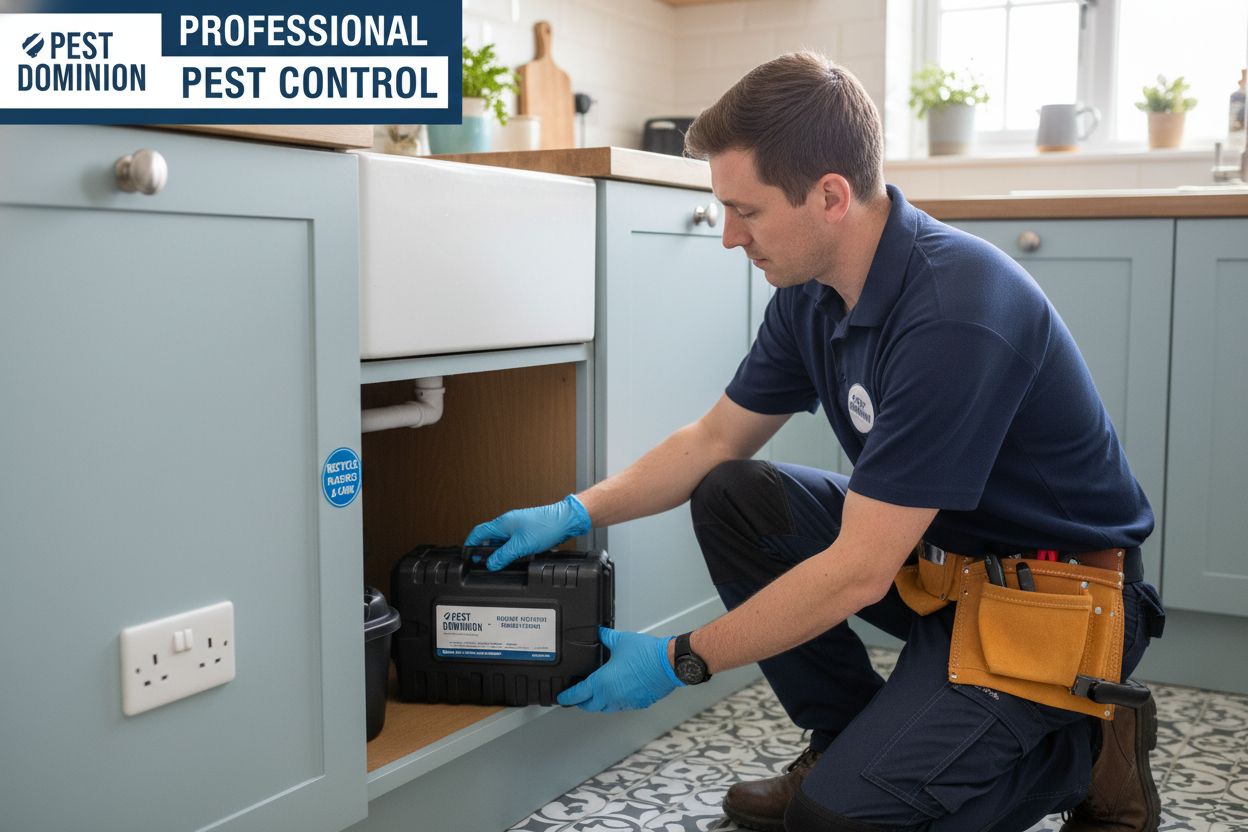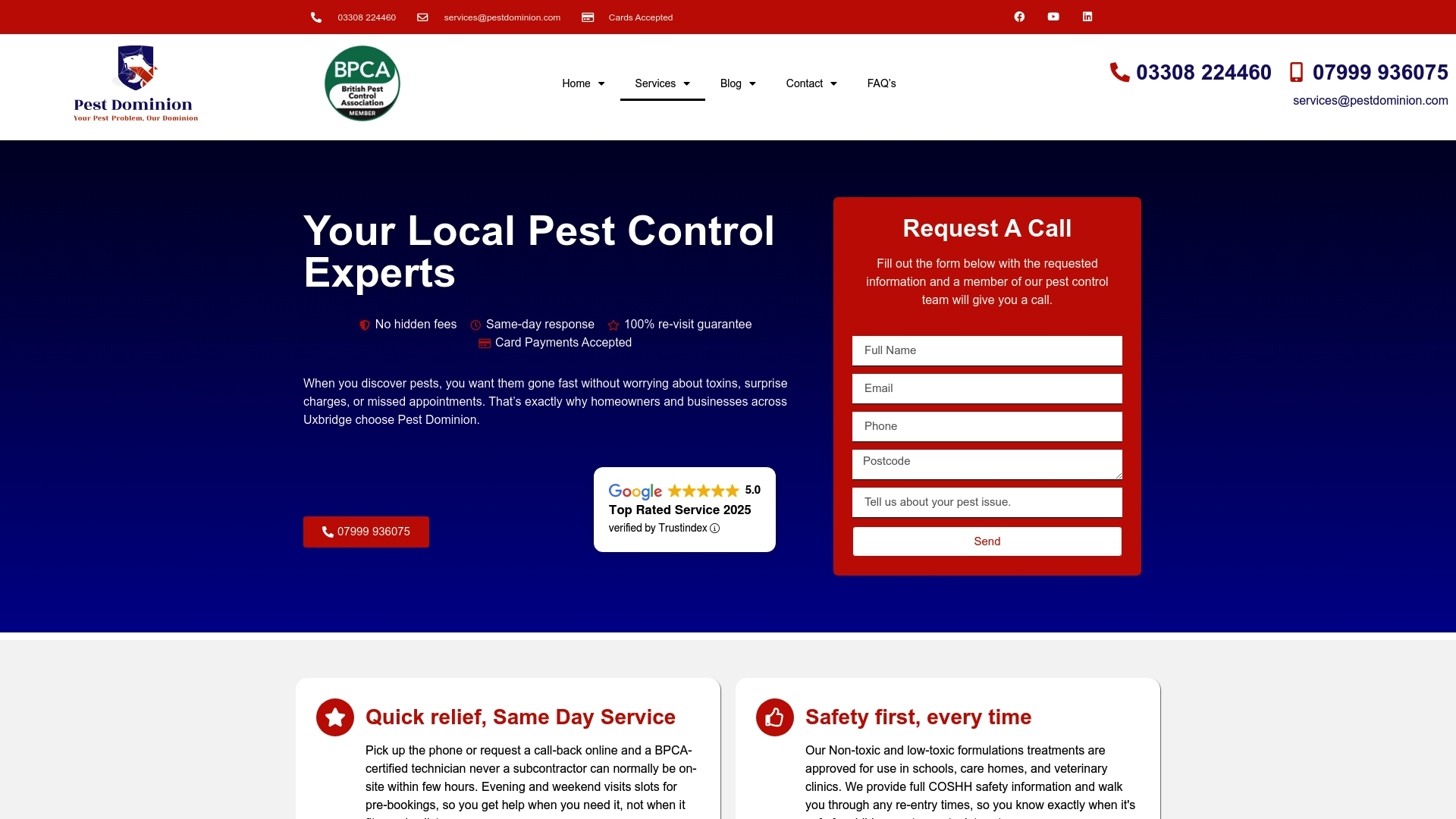Did you know that pest infestations cost UK businesses and households millions every year? The impact is felt not just in lost money, but also in damaged property and health risks. Understanding how pest eradication works helps you protect your space more effectively. Modern strategies often rely on smart, sustainable methods instead of harsh chemicals, making it possible to solve pest problems without harming your environment.
Key Takeaways
| Point | Details |
|---|---|
| Strategic Eradication | Pest eradication is a comprehensive approach that aims to completely eliminate pests, requiring targeted methods beyond simple control techniques. |
| Professional Expertise | Certified pest control professionals utilize advanced methods and adherence to legal standards to ensure effective pest eradication and long-term prevention. |
| Health and Financial Risks | Unmanaged pest infestations can lead to significant health hazards and financial losses, making proactive pest management essential. |
| Informed Service Selection | Property owners should choose pest control services with verified expertise, transparent pricing, and proven success to avoid costly mistakes in pest management. |
Table of Contents
- Defining Pest Eradication And Common Myths
- Types Of Pests And Eradication Methods
- How Professional Pest Eradication Works
- Legal And Safety Standards In The Uk
- Risks, Costs, And Choosing A Service
Defining Pest Eradication and Common Myths
Pest eradication is a strategic process designed to completely eliminate unwanted pest populations from a specific environment, going far beyond simple pest control. Unlike basic pest management that might temporarily reduce numbers, eradication aims to remove pests entirely through comprehensive, targeted approaches. According to what is pest control, this process involves systematic techniques that address root causes and prevent future infestations.
According to Defra’s guidance on Integrated Pest Management (IPM), effective eradication isn’t about blanket chemical treatments, but rather a nuanced strategy involving:
- Prevention techniques
- Continuous monitoring
- Establishing intervention thresholds
- Targeted, precise interventions
Many property owners mistakenly believe pest eradication is a quick, one-time chemical solution. However, the reality is more complex. The Forestry Commission emphasises that true eradication requires biosecurity measures like thorough equipment cleaning, comprehensive surveillance, and proactive reporting. This approach reduces environmental impact while creating sustainable long-term pest management solutions.

Understanding these principles helps property owners approach pest challenges more strategically. Non-Toxic Pest Control methods are increasingly preferred, demonstrating that modern eradication is about intelligent, environmentally conscious interventions rather than indiscriminate chemical warfare.
Types of Pests and Eradication Methods
Pests represent a diverse range of organisms that can threaten property, health, and agricultural systems, requiring targeted eradication strategies. These unwanted creatures span multiple categories, including insects, rodents, birds, and fungi, each demanding unique approaches to elimination. According to Defra’s Pest Risk Analyses, classification and control methods must be precisely tailored to specific biological characteristics and potential spread mechanisms.
Common pest types encountered in UK properties and landscapes include:
Here’s a comparison of common UK pest types and their typical eradication methods:
| Pest Type | Examples | Typical Eradication Methods |
|---|---|---|
| Rodents | Mice Rats |
Trapping Baiting Proofing |
| Insects | Cockroaches Bed bugs Ants |
Chemical treatments Heat treatments Integrated monitoring |
| Agricultural Pests | Colorado beetles Crop insects |
Surveillance zones Biological controls Targeted pesticides |
| Nuisance Wildlife | Pigeons Squirrels |
Exclusion measures Habitat modification Trapping |
| Wood-Destroying Organisms | Woodworms Termites |
Chemical treatments Wood protection Environmental management |
- Rodents: Mice and rats
- Insects: Cockroaches, bed bugs, ants
- Agricultural Pests: Colorado beetles, crop-damaging insects
- Nuisance Wildlife: Pigeons, squirrels
- Wood-Destroying Organisms: Woodworms, termites
Eradication methods vary significantly depending on the pest type. Best Pest Prevention Products play a crucial role in implementing targeted interventions. For instance, the recent Colorado beetle outbreak in Kent demonstrated how precise surveillance within a 5 km zone could completely eliminate an agricultural pest population, showcasing the effectiveness of strategic monitoring and intervention.
Modern pest eradication combines multiple techniques, including biological controls, chemical treatments, environmental management, and technological monitoring systems.
![]() The goal isn’t just temporary removal but creating sustainable, long-term prevention strategies that protect properties and ecosystems from recurring infestations.
The goal isn’t just temporary removal but creating sustainable, long-term prevention strategies that protect properties and ecosystems from recurring infestations.
How Professional Pest Eradication Works
Professional pest eradication is a systematic, scientifically-driven process that goes far beyond simple DIY treatments. Certified professionals bring specialized knowledge, advanced techniques, and regulatory compliance to effectively eliminate pest challenges. According to Defra’s guidelines, professional pest controllers must be registered and hold accredited certifications, ensuring a structured and responsible approach to pest management.
The professional eradication process typically involves several critical stages:
- Initial Comprehensive Inspection: Detailed assessment of the property
- Precise Identification: Determining exact pest species and infestation extent
- Strategic Planning: Developing a targeted Integrated Pest Management (IPM) approach
- Intervention Implementation: Executing carefully selected control methods
- Monitoring and Follow-up: Tracking effectiveness and preventing future infestations
Pest Control Solutions demonstrate that modern eradication relies on sophisticated techniques beyond traditional chemical treatments. Professionals use a combination of biological controls, environmental management, and targeted interventions that minimize environmental impact while maximizing pest elimination effectiveness.
The key difference between amateur and professional approaches lies in the depth of understanding and precision. Professional pest controllers follow strict protocols, use specialized equipment, and apply scientifically-backed methods that address the root causes of pest problems, ensuring long-term protection for properties and ecosystems.
Legal and Safety Standards in the UK
Pest eradication in the United Kingdom operates within a comprehensive legal framework designed to protect public health, property, and environmental safety. Statutory regulations provide clear guidelines for pest control professionals, ensuring responsible and effective management of pest-related challenges. The Prevention of Damage by Pests Act 1949 establishes a fundamental legal mechanism that empowers local authorities to control rat and mouse populations, compelling landowners to take necessary action when pest issues arise.
Key legal standards governing pest eradication include:
- Public Health Protection: Mandatory pest control responsibilities
- Workplace Safety: Health and Safety at Work regulations
- Environmental Compliance: Sustainable pest management practices
- Professional Certification: Required qualifications for pest control operators
- Chemical Usage Restrictions: Regulated application of pest control substances
The Health and Safety at Work etc. Act 1974 further reinforces these standards by imposing strict obligations on employers and contractors involved in pest eradication. Tenant Pest Control Rights highlight the legal protections designed to ensure safe and responsible pest management across residential and commercial properties.
Professional pest control companies must navigate these complex legal requirements, demonstrating compliance through thorough documentation, safe chemical handling, environmental considerations, and adherence to national safety protocols. This legal framework ensures that pest eradication practices protect not just property owners, but also workers, residents, and the broader ecosystem.
Risks, Costs, and Choosing a Service
Pest infestations represent significant financial and health risks that can quickly escalate if not addressed professionally. Comprehensive risk management involves understanding the potential economic and health implications of uncontrolled pest problems. Recent data reveals staggering financial impacts, with NHS Grampian experiencing a 119% increase in pest control expenditure from £47,000 to £103,000 between 2021 and 2025, highlighting the substantial costs associated with pest-related challenges.
Key risks property owners should consider include:
- Health Hazards: Disease transmission and allergic reactions
- Structural Damage: Potential compromise of building integrity
- Financial Loss: Expensive property repairs and treatment costs
- Reputation Impact: Potential business or property value reduction
- Ongoing Maintenance: Recurring treatment requirements
The economic burden of pest infestations is substantial, with English NHS hospitals reporting over 18,000 pest incidents costing nearly £3.7 million. Pest Risk Assessment Policy becomes crucial in understanding and mitigating these potential risks before they become catastrophic financial burdens.
When selecting a pest control service, prioritize professionals who offer comprehensive risk assessment, transparent pricing, and proven track records. Look for certifications, comprehensive insurance, detailed inspection reports, and guarantees of follow-up treatments. The cheapest option is rarely the most effective, and investing in a quality pest control service can save significant money and stress in the long term.
Take Control of Pest Eradication with Local Experts You Can Trust
When pests threaten your home or business, temporary fixes just do not work. As explored in our guide on pest eradication, ignoring the root cause or choosing one-off treatments can result in recurring infestations and costly repairs. Professional support matters, especially when health, safety, and long-term protection are on the line.

Experience peace of mind and thorough results with Pest Dominion Limited. Our team uses tailored, compliant methods and an in-depth approach that ensures pests are not just controlled, but eradicated. Ready for a cleaner, safer environment? Learn more about our pest control solutions or contact us now at Pest Dominion Limited and start protecting your property today.
Frequently Asked Questions
What is the difference between pest control and pest eradication?
Pest control focuses on reducing pest populations, while pest eradication aims to eliminate them completely from an environment through comprehensive, targeted strategies.
What are the common methods used for pest eradication?
Common methods include trapping, baiting, chemical treatments, biological controls, and integrated pest management practices that emphasize prevention and monitoring.
How do professional pest eradication services work?
Professional pest eradication involves a systematic process including an initial inspection, precise identification of pests, strategic planning, targeted interventions, and ongoing monitoring to ensure effectiveness and prevent future infestations.
What legal standards govern pest eradication practices?
Legal standards include guidelines for public health protection, workplace safety regulations, environmental compliance, certification requirements for pest control operators, and restrictions on chemical usage.

